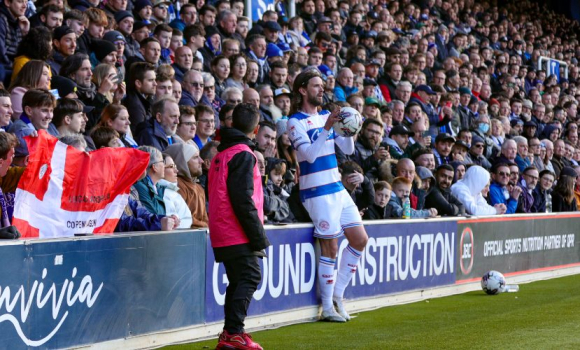A season of three thirds: how Cifuentes and QPR beat the drop – Analysis Monday, 3rd Jun 2024 12:52 by Andrew Scherer Columnist Andrew Scherer returns with an end-of-season deep dive into the facts and figures behind Marti Cifuentes’ rescue job on QPR’s class of 2024. I am not, by any stretch, a psychologist. But any armchair Freud could tell you a lot of football fan behaviour is driven by a desperate need to comprehend and influence things outside of their control. Exhibit A: an emergency clothes wash at 7am on Friday morning because you realise your lucky Stan Bowles socks are in the laundry basket. Exhibit B: going the exact same way to the tube en route to Loftus Road if you won last time out. (Guilty on both counts). Exhibit C: the flood of money put on QPR to go down before the Leeds game, despite the near-unprecedented series of results needed for that to happen. A collective penance paid to Sod and his bloody law: “If I spunk ten quid up the wall at Paddy Power maybe you could let us stay up?” Here I will dig into the season’s data to pull apart how Cifuentes and QPR went from odds-on relegation candidates in January (I predicted QPR would finish 22nd) to a side that won ten of their last 19 games to secure safety with something to spare. I’ll break down everything from our mentality shift to our miserly defence…but I am yet to quantify how much those lucky socks contributed. Reviewing my predictionsLet’s start, then, with my predicted final table from January. Turns out not only did I underestimate QPR, they were the team I most underestimated, by quite some margin. 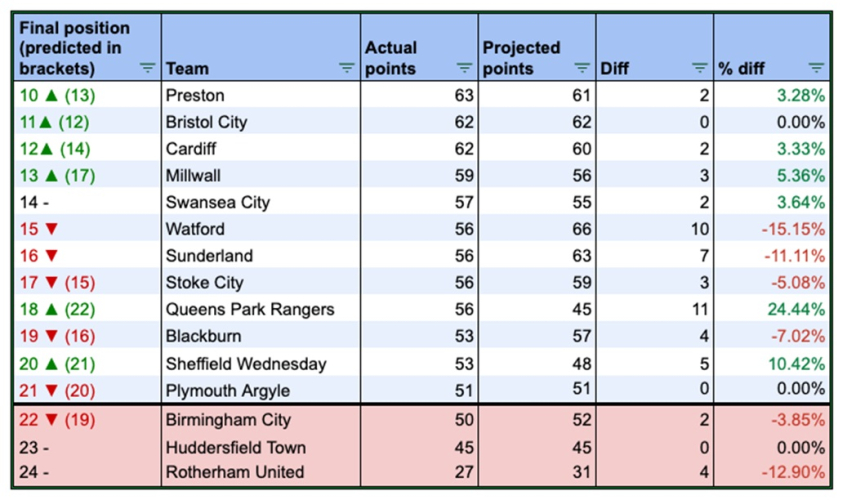 There were some other misses: Sheffield Wednesday’s own Danny Röhl-inspired great escape was even more impressive than anticipated, while Rotherham rather gave up the ghost and Blackburn’s freefall was even worse than expected. I had to go back and re-run the data to see where the model had Watford and Sunderland finishing, given at the time of my predictions they were a full 18 and 19 points ahead of us in seventh and eighth respectively. Though it’s a wonder I didn’t anticipate the full force of the Beale Effect™ on Sunderland. And Watford gonna Watford. 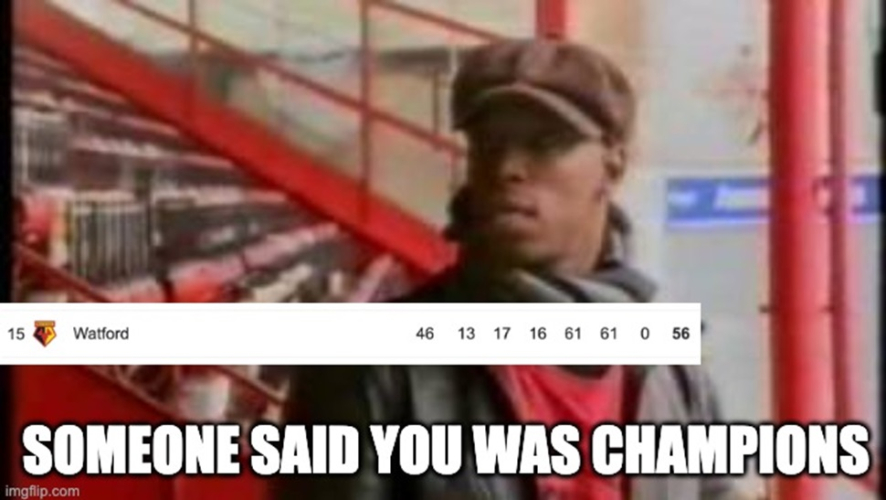 Nevertheless, my predictions overall might yet help me claw back some credibility. Three teams’ points totals were spot on and a further six teams were within three points. I reckon that’s not bad going overall, given every club here (bar Preston and Cardiff) changed manager at least once during the season. So, if you accept that the prediction model does bear some relation to reality, the obvious question that follows is: how the hell did QPR manage to outperform it quite so much? Let’s see if we can find out. QPR’s core statsWe’ll start with the core performance numbers. For ease of comparison, I have broken down our season into three sections: Ainsworth (14 games), Cifuentes - part one (13 games), and Cifuentes - part two (19 games). The Cifuentes split is the somewhat arbitrary period pre and post my last article, though given the upturn in form which followed that piece it’s not a bad marker for trying to establish what drove our season-saving improvements. Coincidentally, it also marks the point at which we parted with Andre Dozzell. As you can see, we went from trundling along well below the league average for every single measure to outperforming it almost across the board.  By way of benchmarking, in a typical season one point per game will just about keep you up, 1.5 points per game would probably leave you just outside the play-offs, and if we maintained the 1.84 points per game we recorded in our final 19 matches across a full season, that would be good enough for third or fourth. The improvement was, therefore, very impressive (in case you were in any doubt). But, as we know from bitter experience, putting together a run of results for a portion of one season is by no means a guarantee of success across the entirety of the next. It’s also interesting that our underlying numbers don’t look that different between the two Cifuentes periods. There’s an uptick in xG and our xGA actually gets a little worse, but the change isn’t commensurate with such a big shift in outcomes. So how, then, did we go from relegation to promotion form? And is this sustainable enough to start looking to a top half finish (or more)? MentalityYou will note that in the first block of Cifuentes games we scored at a rate consistent with our xG but underperformed our xGA. At the time, I suggested that there was a potential mentality issue at play: we were soft on set pieces and while we were in a lot of close matches, when it came to the crunch we just didn’t get the job done. Let’s revisit the scatter plot showing points returns for teams across the league against the amount of time they spent within one goal of the opposition (i.e. leading by one, losing by one, or drawing), with Ainsworth’s QPR, Cifuentes part one, and Cifuentes part two split out. Now, doesn’t that look better? Since January we have remained relatively high in the tight match table but what a turnaround in terms of converting those games into points.  How? Well, we’re obviously talking about small sample sizes but there are some themes which emerge when you look at the two sets of matches. Most notable, perhaps, is getting the opening goal of a game. In the first Cifuentes period, we scored first in 38.5% of the games. In the second period, that jumps to 57.9%. With a pretty miserly defence but less threatening attack this is crucial. Additionally, we found a way to get back into games when going behind. The first block of Cifuentes games only saw us rescue points from a losing position in one game: Stoke at home (against ten men). Conversely, we drew three and won two of the games we were losing in the second Cifuentes period. You can see this improvement in performance at key moments when you compare our proportion of xG created by game state. Relative to the time spent in each game state (leading, losing, drawing), we got better at fashioning chances when level or behind – allowing us to convert more tight games into points. Interestingly, we clearly also felt more happy sitting back and defending a lead as the season wore on. 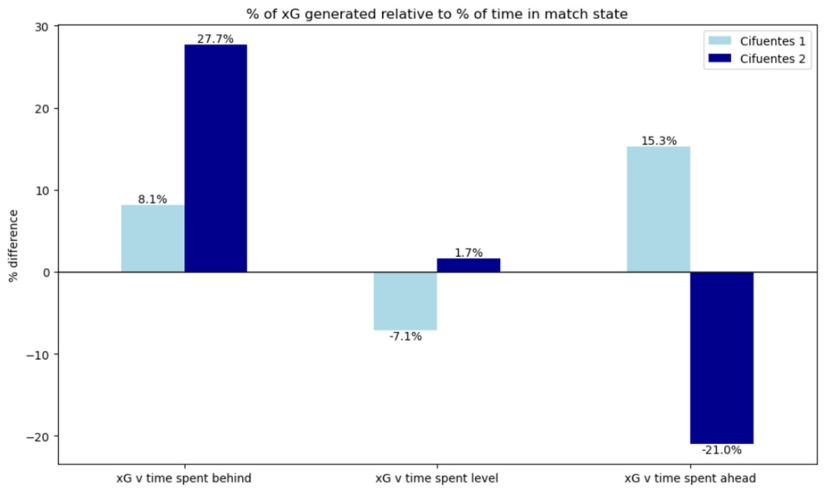 Ultimately, ‘mentality’ is inherently difficult to measure. But, if we were happy to use it to explain some of our failings when things were going less well, then it must also hold true that it’s shifted around and contributed to our good form. As Clive highlighted in his Coventry match report, it is telling that since arriving here Cifuentes has consistently talked about upholding standards, not making excuses, and creating a winning mindset within the club. Perhaps, perhaps, this is starting to bear fruit on the pitch. Set piecesWe could not, of course, do a walkthrough of QPR’s improvements in the last few months without spending some time on set pieces – particularly in the context of managing to win more tight matches. As before, I defer to the excellent Dan Lambert for some genuine tactical insight into what has changed, but I will put some numbers on the shift to quantify it: In line with our broader development as a team, Cifuentes’ first period saw an improvement in the defending of set pieces relative to what we saw under Ainsworth (in terms of overall quality of chances conceded – that’s not to say we did well), while our attacking output actually drop very slightly. The big shift, however, comes in the second period, as our set piece xG per game almost doubles(!), while we see a further drop in xGA. That change in dead ball threat accounts for around 75% of the increase in our overall xG for that period: this really was a key part of our survival.  What drove the improvement? As Dan outlines, the planning and execution of our routines has stepped up a level, while Lucas Andersen deserves a lot of credit: his delivery is undoubtedly a big upgrade (more on him later). But there is one further bit of secret sauce that stands out in the data and which has been a real game changer. You might not have come across this niche concept before, so I will try and explain it in relatively simple language: We packed the team with a load of big men. Since Bristol City away (the beginning of the great Jimmy Dunne experiment), we’ve started every game with at least five outfield players over six feet. Prior to that, we hadn’t started any games with more than four. You can see the difference this makes in output: 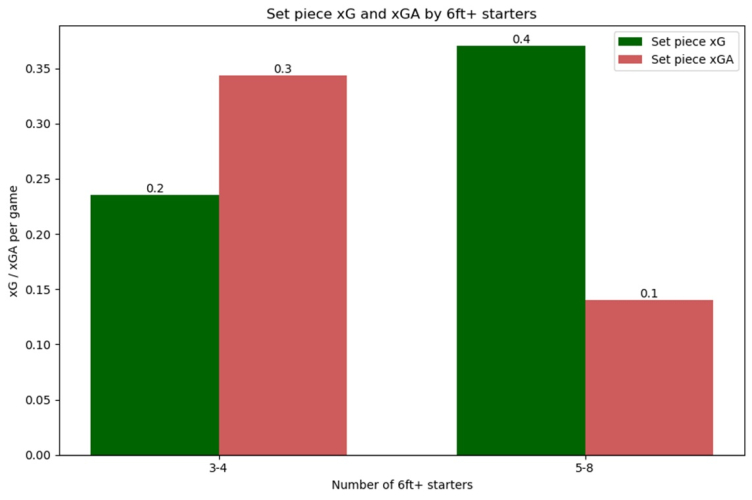 I am not for one second downplaying the work that has gone into turning things around in this area: it has been a monumental effort by players and coaches alike. And you might argue this data shows correlation but not necessarily causation. But when analysing sport we can sometimes get a little stuck in the weeds of things and lose sight of some simple truths. Football is a physical game. Physical advantages, whether height, strength or speed, convey an inherent advantage. If you’ve been struggling with balls into the box at both ends of the pitch, maybe getting more tall bodies in there helps quite a bit. The importance of physicalityThe benefits of height are not confined to set pieces, of course. It is no coincidence that Arsenal and Manchester City are big sides: as well as dominating dead balls, they are relentless in pinning teams back and also defending their own area when necessary. If we take a relatively simple measure – percentage of aerial duels won – we can see this in action for the Rs as well.  Under Ainsworth and in the first Cifuentes spell we were pretty average at winning headers. But in the second Cifuentes period we came into our own, with a league-leading 57.75% of aerial duels won in the final 19 games of the season. And in case you are sceptical as to whether this really matters for winning games, over the whole Championship season the top teams for percentage of headers won were: Leicester, Ipswich, West Brom and Leeds (and this is not purely because more successful teams rarely play longer, lower percentage passes: Ipswich and West Brom’s total aerial duels were both around the league average). Clearly, physicality alone is not going to set you up for success. But it is an edge that might contribute to turning a losing record in tight matches into a winning one. AttackIn January, I hypothesised that the improvement in defence (xGA having more than halved from 1.61 to 0.81/game) relative to the limited improvements in attack since Cifuentes’ arrival might have been a question of prioritisation. Joining a mid-season firefighting job meant only so much time on the training ground with the team, so the first job was always going to be stopping us conceding at a silly rate. Once that was under control, he could start to develop a structure and patterns of play that would enable us to carry more offensive threat. While we have still struggled to trouble teams consistently and, as we have seen, a good chunk of the improvement has been driven by set pieces, the attacking output has improved:  What’s changed? Firstly, there has been a notable shift in our possession-based approach. In the first Martí spell, we were a big outlier in terms of having more of the ball than the opposition but creating less than one expected goal per game. In the second Martí period, our average possession has dropped significantly but, in contrast to the general trend line, our xG has increased so that we are now over-performing relative to the typical xG recorded by a side with an average of 47% possession.  When we checked in on progress in January, I flagged that our wins had exclusively come in games where we had possession of 50% or less. Since then, we have recorded ten more victories and (bar Birmingham at home) they have all adhered to this rule. Some of this lower possession will, of course, be driven by getting ahead in games and therefore being able to defend a lead. But the fact this is an active choice shows up in other data points too. Initially under Cifuentes, we were progressing the ball into attacking positions much more frequently than under Ainsworth (playing over 25% more passes into the final third), but struggling to break down sides once there (our xG only increased by 0.11 per game). Since January, however, our passes into the final third per game have almost reverted back to Ainsworth levels. This seems pretty counter-intuitive and was certainly enough for me to double check my numbers, but yes – we really have had a significant drop in passes into the final third. Why? And how can this be the case for a side that has scored more in the last three-four months?  Well our passes per game into the penalty area and our xG have continued on an upwards trajectory throughout Cifuentes’ reign. In other words, we are playing the ball into the final third less but getting the ball into dangerous areas more – i.e. we are much more efficient with possession. Looking at passes into the final third versus passes into the penalty area across the league, there is unsurprisingly a clear correlation – and while initially under Cifuentes we were below that trend line, in the second Cifuentes period we were well above it.  So, I think it’s safe to say that once Cifuentes had got a handle on what the players realistically could and couldn’t do, he established game plans that played to their strengths and that would win us games. Rather than attempt to dominate the ball with a squad that isn’t built for that sort of football, the manager realised that surrendering possession and making the most of transitions would be more effective. If we break down things even more and look at what we do with the ball once in the final third, what really stands out is our crossing, which has shifted dramatically under Cifuentes, both in terms of volume and quality.  As you can see, we were broadly in line with the league average for crosses per game under Ainsworth but our completion rate was poor. Initially under Cifuentes our number of crosses per game spiked to among the highest in the league but with limited improvement in success rate, before the dramatic jump in percentage of completed crosses in the second Cifuentes period (putting us in the top three for this stat). My hunch is Ainsworth would have liked to have got more crosses in but just couldn’t set the team up to get the ball into dangerous wide areas enough. In Martí’s first period the success rate suggests we were playing the ball in against defences that were well set and/or with few players on hand to challenge for the ball. Conversely in Martí’s second period, as we looked to win the ball and get it forward more quickly, crossing became a much more effective means of creating opportunities (think Dykes to Chair at Leicester or Andersen to Chair at Bristol City). One final morsel from the attacking data, that perhaps speaks to Cifuentes’ willingness to take more risks once the defence was on firmer footing. Here are the numbers for actions that led to a shot, by manager: 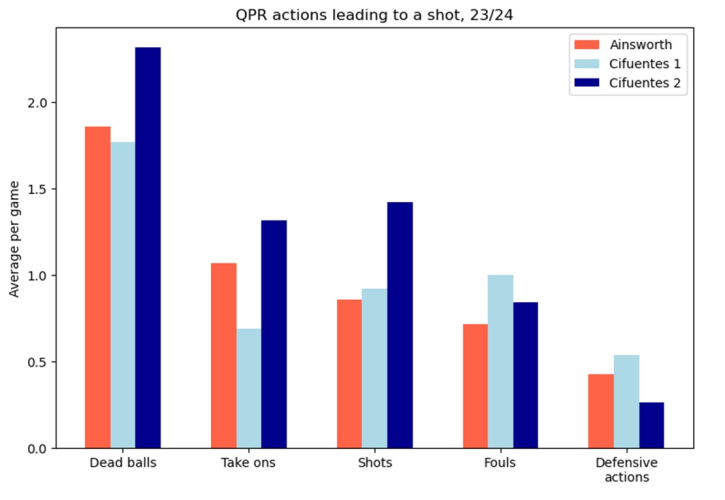 What’s noticeable is the big drop in take ons that lead to a shot when Cifuentes took charge, followed by their jump back up. This might just be a quirk of the data, so I wouldn’t automatically attach too much importance to it, but I can certainly see a world where Cifuentes wanted to be comfortable that the defensive shape was sound before allowing players to attempt higher risk/higher reward actions in attack. And, as we shall see shortly, a change in personnel might have been the key that allowed his best dribbler to do this closer to goal. The spike in threat from set pieces also shows up here, along with an increase in shots that led to other shots. Given more than one action can register as contributing to the same shot, these are likely linked: we saw that getting dangerous balls into the box from dead balls often led to goals on the rebound when initial efforts on goal were blocked or saved (eg Cook versus Birmingham or Field versus Plymouth). Finally, all of the above is borne out in the shooting data: our volume of shots per game is pretty consistent across both Cifuentes periods but the quality (as measured by distance and non-penalty xG) jumps up - demonstrating our ability to manufacture more threatening attacking situations.  Position of marker represents average shot distance, its size represents volume of shots, and opacity represents average npxG per shot. To summarise, then, there have undoubtedly been improvements in our attack. Cifuentes has found ways, whether through set pieces or trading possession for transitions, to cause more problems to the opposition and this was absolutely key to our survival. Even with these improvements, however, our xG per game since mid-January was still lower mid-table level. And despite outperforming it, our actual goals scored were still only in line with the league average. To achieve the sort of results consistently that will get us into the top half, we will need to see even more upgrades in our attacking output. DefenceUnlike our attack, our defence has remained highly competitive throughout Cifuentes’ reign. And although we were allowing a little more in the way of xGA in Cifuentes’ second period, we were still well below the league average. What is interesting is how our approach to defending has evolved. Initially under Cifuentes, we seemed to focus on crowding the middle of the pitch and preventing teams from easily getting at our goal. Latterly, this hasn’t been the case as we have moved to a defensive setup with two distinct phases. Firstly, our high press, where we have been increasingly active pinning teams back and winning the ball closer to the opponent’s goal to spring dangerous attacks. 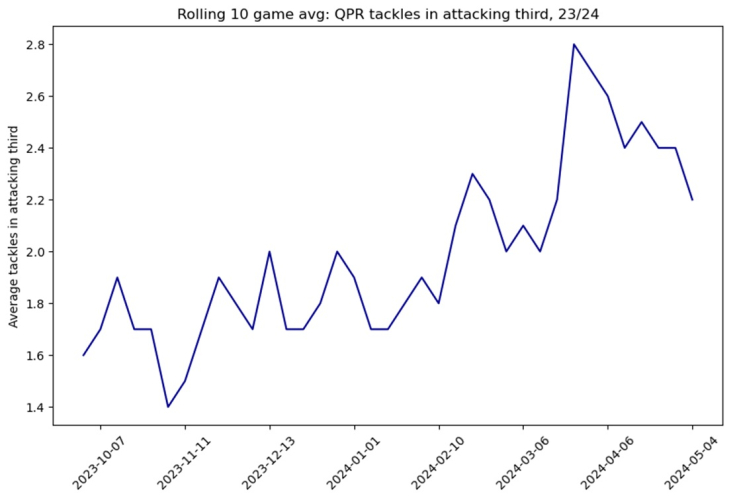 This passes the eye test: I would have said we seemed to open up a little more in the second half of the season, took a few more risks with keeping players high, and accepted a little more defensive threat as a result. An effective press also requires consistent teamwork and understanding of off-the-ball roles – something that (I suspect) would take a new manager some time to instil. Secondly, we combined this high press with a complementary approach: a low block that denies opponents clear-cut chances once they get into dangerous areas. As the following graph shows, initially under Cifuentes we allowed very few passes into our defensive third. Since January, however, we have been well above the median level for this measure but the passes into our area are well below the trend line.  Some of this change may well be a factor of leading more games and being able to defend a lead, but the change from being more active in the middle of the park to the high press/low block approach can also be seen in where we made our tackles:  The first spell under Cifuentes doesn’t look that dissimilar to our tackling under Ainsworth but in the second that big drop off in midfield tackles certainly suggests there was an active decision to shift the focus of our engagement without the ball to the attacking and defensive thirds. What does this mean in practice? Well let’s plot passes allowed into the final third against xG conceded. If you take each quadrant as a different playing style (top left: dominate territory but still concede good chances, top right: concede territory and lots of chances; bottom right: concede territory but defend goal effectively; bottom left: dominate territory and do not concede many chances), we have occupied pretty extreme ends of three different approaches in one season. 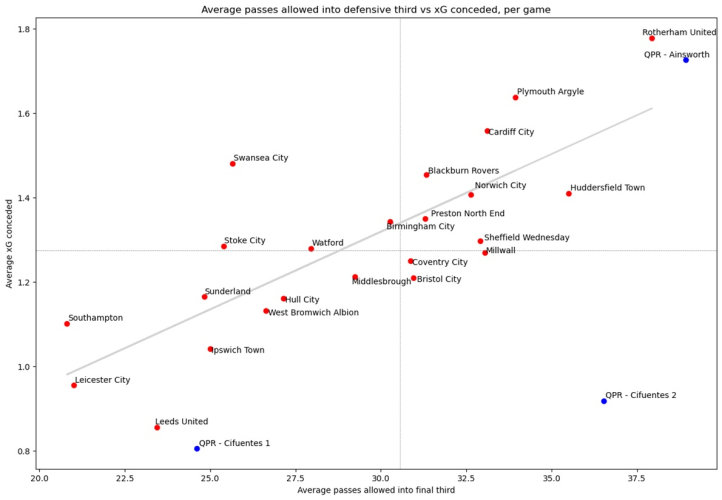 Some of this is a factor of who we have been playing (eg we didn’t play Leicester or Leeds during the first Cifuentes spell), but the difference couldn’t be more stark. We were wide open under Ainsworth; Cifuentes came in and we stifled teams in the middle of the pitch (perhaps sacrificing some attacking threat); then we pressed higher, accepted a little more risk, but were quick to drop back into a – very effective – low block once teams progressed the ball out. This also better suited the players at our disposal and is another example of Cifuentes’ pragmatism: work with the ingredients at your disposal and trust the Cook. Ironically (or, perhaps, naturally), this is a lot closer to what I hoped we might get with Ainsworth. Sadly, Wild Thing wasn’t able to make it work. Cifuentes has taken this Ainsworth-ball squad, developed an approach that is not necessarily his preferred style but fits the players, and got results. January transfersFinally, while Cifuentes deserves huge credit for turning things around, it would be remiss not to spend some time looking at the impact of our January signings. - Lucas Andersen I will dwell longest on Lucas Andersen. Partially because I have strong feelings, both on and for him, but also because his impact is the most significant of the four new arrivals. From the word go I’ve been purring at the way he can dictate attacks, deliver set pieces, and lead our press. His arrival gave the manager a different sort of option in the middle of the park and, I would argue, facilitated some of the changes we saw in our approach, both going forward and defensively.
That is all a little misty-eyed for a data-focused piece, though, so let’s try and quantify it a little. Since joining, Andersen had the highest progressive passes per 90 of anyone in the squad and he is only second to Ilias Chair for expected assists. It is also no coincidence that our set pieces have improved: the Dishy Dane creates an average of 1.58 shooting opportunities per game from his dead ball delivery (fifth best in the league); our next highest contributor is Kenneth Paal on 0.68. And he averages 1.09 interceptions per 90, only bettered by a selection of defensive-minded players (Hayden, Cannon, Colback, Field, Cook and Paal). He is, in short, very good. If we can keep him fit, I have high hopes for what he can do for us. While we are obviously talking about very different levels, I can see Cifuentes building a team around him next year in the same way Mikel Arteta has with Martín Ødegaard at Arsenal. It is not just Andersen’s own contributions that have been important: his presence has also enabled us to deploy other players more effectively, most notably Ilias Chair. No longer having to write the theme tune and sing the theme tune on behalf of the entire team, there is an interesting shift over the course of the season in the areas where Chair is getting on the ball. 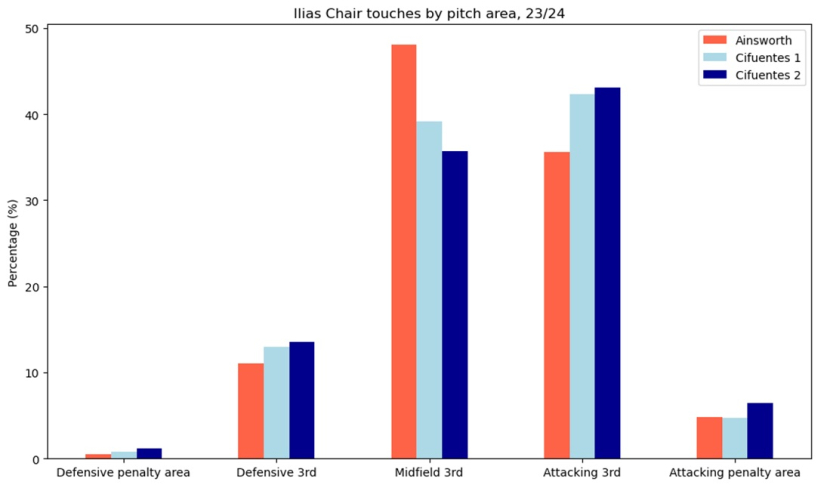 As I flagged in October, under Ainsworth Chair seemed to be playing a lot deeper. This helped with our limited ability to get the ball forward but robbed us of our best attacking talent where it really counted. This has progressively improved under Cifuentes so that Chair now has little more than a third of his touches in the middle of the park and almost half in the final third and opposition penalty area. We can see where this is having a positive impact: the Moroccan’s key passes (passes that lead directly to a shot) are up from 1.55/game in Cifuentes’ first period to 2.53 in the second, while his completed crosses into the penalty area are up from 0.5/game to 1.06. We should note that his expected assists are down a little (from 0.23/game to 0.22/game) but it is a marginal difference and these are also being spread more widely across the team. Between his own contributions and his facilitation of other players, I would call Lucas Andersen’s arrival a pretty big success. - Isaac Hayden Looking at some key metrics, Hayden topped the QPR squad (minimum 10 games) for: headers won (76%!); tackles won per 90 (1.55); blocks of passes or shots per 90 (1.73), and interceptions per 90 (2.27 - second best in the league). That is a significant contribution.  Whether we try and keep him is an interesting one. Although he clearly made an impact, Hayden is not the right age profile, dropping down a level, and likely to command a decent wage. On the flip side, I’m not sure we have another midfielder who offers quite what he does (both Colback and Field tending to be a little more advanced), so I do think we are currently light a midfield enforcer. I think that gap needs to be plugged but I am relaxed as to whether that is with a different signing, or with Hayden on terms favourable to us. - Frey and Hodge There’s not really enough data to get a clear picture on either of these two. It’s a little unclear why Hodge faded from contention so quickly after his strong start but Cifuentes does seem to take a firm view on players and for whatever reason this one didn’t quite work out. My entirely unscientific view on Frey is that, if we can get him fit, he is a useful option to have in the squad with his height and presence in the area (see above re value of physicality), and because Cifuentes clearly trusts him to follow instructions in terms of defensive shape. - Dozzell I am not minded to spend too long dwelling on (friendly) ghosts of Christmas past but I will proffer a quick stat to send Andre on his way, with a nod to this summer’s departures too. Over the course of 2023/24, the three QPR players with the worst gap between goal difference with them on pitch versus goal difference without them (min ten games) were: Begovic, Kakay, and Dozzell. And no, the Begovic one isn’t in any way fair as it was only one game but I’ll allow myself this one. So…what’s next?Which brings us to a fascinating and potentially pivotal off-season, both for Cifuentes and Christian Nourry. I’m definitely chalking January up as a success: if 50% of our summer signings have the sort of impact Andersen and Hayden did, I’ll be very happy. And we will almost certainly need to have some transfer wins before August, with players like Begovic and Willock out of contract, loan players having returned to their parent clubs, and potential moves already rumoured for our better performers of the last 4/5 months. The big question that underpins all that activity is, having found a happy medium between his preferred system and one that worked for the players at his disposal, will Cifuentes want a pre-season of evolution or revolution? Whatever direction we do take, it does feel (very tentatively – we’ve been burned enough times before) like there will at least be some consistent strategy and planning behind what we do, from the CEO down to the head coach. And whoever ends up lining up for us after September 2, on the evidence to date you wouldn’t bet against Martí finding solutions to make it work. Hope everyone has a great summer and see you in August. You R’s. More from this author >>> Destroyer of optimists >>> Light at the end of the tunnel? If you enjoy LoftforWords, please consider supporting the site through a subscription to our Patreon or tip us via our PayPal account loftforwords@yahoo.co.uk. Pictures — Ian Randall Photography The Twitter @scheza, @loftforwords Ian Randall Photography Please report offensive, libellous or inappropriate posts by using the links provided.
You need to login in order to post your comments |
Blogs 31 bloggersCoventry City Polls |

